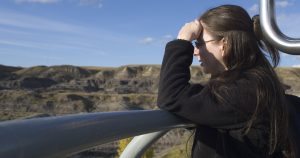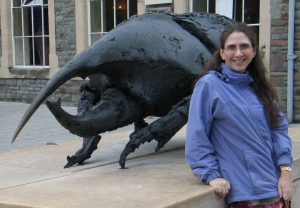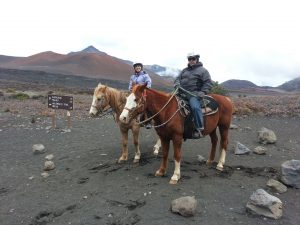Allison Tumarkin-Deratzian – 1997
Allison Tumarkin Deratzian 1997

Surveying the Badlands
Like most young children I’ve ever met, I was fascinated by dinosaurs and other extinct animals as far back as I can remember. Growing up outside New York City, I made frequent visits to the American Museum of Natural History, and I suspect drove my parents to distraction by always wanting to visit the fossils halls, and the halls of modern reptiles and mammals, to the exclusion of pretty much everything else. In spite of this, I never thought too seriously about studying paleontology early on. My high school offered no courses in Earth Science, and when I began the college search I was looking for biology programs as preparation for possibly veterinary medicine. (At the time, however, I was also allergic to most things with fur and feathers, which made me think that perhaps a career as a vet was not the best match.) Somewhere during my visits to multiple colleges, I remembered the still-there-but-somewhat-neglected childhood fascination with fossils, and decided it couldn’t hurt to look into vertebrate paleontology, since that would mean the ability to work with animals that I wouldn’t be allergic to. Most of the biology programs I was finding were highly focused on pre-med students, so it occurred to me that geology might be a better option for studying earth history and paleontology, and I switched my search to geology with a side of biology. And so I arrived at Lafayette a declared Geology major, having never taken an Earth Science course in my life.

Allison at the Society of Vertebrate Paleontology meeting in Bristol, UK.
Currently I am an Associate Professor of Instruction in the Department of Earth & Environmental Science at Temple University in Philadelphia. I am primarily teaching faculty, but I also do research on dinosaur biology and evolution, advise Master’s-level grad students, and since 2011 have served as our department’s Undergraduate Advisor for Geology and Environmental Science majors. I teach introductory historical and physical geology classes, as well as upper-level courses in stratigraphy, invertebrate paleontology, and vertebrate paleontology and taphonomy. Thanks to my Lafayette paleontology course with Dr. Richard Faas, I still refer to the extinct animals as “critters,” as do most of my students.
After graduating from Lafayette, I entered the Ph.D. program in the Department of Earth and Environmental Science at the University of Pennsylvania. My advisor at Penn, Dr. Peter Dodson, has a joint appointment in geology and the Department of Animal Biology in the School of Veterinary Medicine. While in grad school, I continued the pattern of taking both geology and biology classes, and also spent four years as a teaching assistant for the veterinary gross anatomy course. (Luckily many of the allergies had subsided by the time vet school came back to haunt me.) I also had the opportunity to participate in paleontological excavations in Montana, Alberta, and Egypt’s Western Desert. My Ph.D. research was on the biological side of paleontology, focusing on patterns of bone growth in horned dinosaurs, macroscopically and in thin-section. After graduating from Penn, I was a Visiting Assistant Professor for three years in the Department of Earth Science and Geography at Vassar College, before starting my current position at Temple in 2006.

Allison in Shakespeare’s “A Midsummer Night’s Dream”
In addition to juggling the Geology major and multiple biology courses, at Lafayette I was highly involved with the College Theater program, acting in plays and musicals in most semesters. Acting was a huge part of my social life and provided an outlet for the artistic side of my brain. That experience at Lafayette (and later, as I returned to active participation in the Philadelphia area community theater scene in 2009) has also been invaluable to shaping my development as a teacher. With most of my classes at Lafayette, Penn, and Vassar being relatively small, it was a daunting experience to walk into a 200-plus student lecture hall my first semester at Temple, but it would have been much worse had I never “performed” in front of an audience. I tell my colleagues that my teaching has benefited as much from my theater background as from my geology and paleontology studies. Apparently the merging of the two has been successful—in 2015 I was awarded Teacher of the Year by Temple’s College of Science and Technology. The moral of that story—don’t be afraid to indulge your passions outside of your primary field of study. They may come in handy in unforeseen ways down the line.
The most transformative experience for me at Lafayette was easily the January interim-session course on Geologic Evolution of the Hawaiian Islands (even though there were no dinosaurs). That was my first immersion into field geology, and the experience of learning, in situ, how to peel back the layers of time to read the history of a landscape completely changed the way I have looked at the world around me. More than any other class I have ever taken, it demonstrated that every place has a story, if we only have the tools to decode it. This is something that I try to communicate to my current students on all my field trips—understanding geology gives us a deeper and richer way to view the world, because we can see both the present and the past all around us.

Horseback Riding on Haleakala Volcano
To the student who may be interested in a career in paleontology:
- Prepare yourself from the beginning to enter a highly multidisciplinary field. While most people will ultimately specialize either on the more geological or the more biological side, to be a good paleontologist is to understand both the rocks and the critters as living organisms. And, as I did at Vassar and Temple, you may end up doing research on one side of the spectrum while teaching on the other. At the very least, take courses in both geology and biology. A double major looks great on a grad school application, but isn’t absolutely necessary, based on my own experience as a student and evaluator of incoming grad student applications.
- Yes, you will most likely need grad school, at least for a Master’s degree.
- If possible, do research as an undergraduate. Doing a senior thesis made my transition to grad school research much less intimidating than it might have been otherwise, and graduate faculty like to take on students who have some research experience.
- Join a professional society (e.g. GSA, The Paleontological Society, The Society of Vertebrate Paleontology) and, if possible, attend a conference your junior and/or senior year. This is great for seeing research options and networking for grad schools. Presenting senior research if you have it is fantastic, but even simply attending is valuable experience for getting the pulse of the field.
- Don’t neglect your other interests and hobbies. They will keep you sane, and may be more relevant than you realize (see the college theater discussion above).
Useful web-links:
University of Pennsylvania Department of Earth & Environmental Science
https://www.sas.upenn.edu/earth/
Temple University Department of Earth & Environmental Science
My own professional webpage
http://sites.temple.edu/vertpaleo/
Society of Vertebrate Paleontology
The Paleontological Society